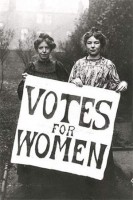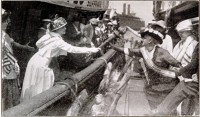By Maureen Wlodarczyk
With about 8 months to go until the presidential election, the raging rhetoric and political pontification threatens to leave potential voters tone-deaf, disgusted, and dubious that their vote matters. That being said, it will do us all good to remember the struggle of one group of Americans desperate to have that right to vote: the ladies of the women’s suffrage movement of the 19th and early 20th centuries. 

- Suffrage Leader Alice Paul
 As early as the 1850s, with the cry “Votes for Women,†suffragettes banded together in pursuit of a place at the ballot box, led by movement pioneers Elizabeth Cady Stanton and Susan B. Anthony. Success remained elusive and as the quest for universal suffrage struggled on at the dawn of the
In the second decade of the 1900s, one Hudson newspaper carried a column titled “Woman’s Suffrage Forum,†a  regular feature that included information on local women’s suffrage lectures, events, news and campaigns and also reported national progress as individual states voted for (or against) extending the right to vote to female residents. In 1915, New Jersey suffrage supporters succeeded in getting the question on a statewide referendum to be voted on in October of that year. In August, as the election drew near and a woman’s right to vote in New Jersey lay in the hands of the men of our state, the pages of local papers carried news of the upcoming arrival of the “suffrage torch†in Jersey City. The torch, symbolically unlit to represent the enlightenment that would come from granting we Jersey girls the right to vote, was to travel throughout the state to raise awareness and popular support for the upcoming suffrage amendment vote. The torch’s travels across the Garden State were to be accompanied by celebrations and ceremonies attended by politicians, prominent citizens and the leaders and members of the Women’s Political Union (WPU).Â

- The Hollbrook Tug Boast
On August 7, 1915, the suffrage torch, accompanied by members of the New York contingent of the WPU, departed New York on the tugboat Holbrook and headed across the Hudson River. At the same time, representatives of the New Jersey WPU left Jersey City on the tug A.W. Smith, set to meet their New York sisters in the middle of the Hudson precisely at noon. The torch handoff on the Hudson completed, the New Jersey delegation tug returned to the Pennsylvania Railroad pier after which a series of ceremonies and outdoor meetings were scheduled, the first starting at 1 pm at Montgomery and Washington Streets.
 The handoff and return of the banner-emblazoned tug with a member of the New Jersey delegation triumphantly holding up the suffrage torch were memorialized in two photographs that speak to the happy occasion and hopes for the upcoming special election. Sadly, despite all their efforts, October did not bring the suffragettes a victory and the right to vote. Over 300,000 New Jersey men voted in the special election and while 42% of them were in favor of giving women the right to vote, the majority voted no and the amendment was defeated. Worse, that defeat meant the amendment could not be brought up for another vote in New Jersey for several years, a stinging blow to supporters of the suffrage movement.
The handoff and return of the banner-emblazoned tug with a member of the New Jersey delegation triumphantly holding up the suffrage torch were memorialized in two photographs that speak to the happy occasion and hopes for the upcoming special election. Sadly, despite all their efforts, October did not bring the suffragettes a victory and the right to vote. Over 300,000 New Jersey men voted in the special election and while 42% of them were in favor of giving women the right to vote, the majority voted no and the amendment was defeated. Worse, that defeat meant the amendment could not be brought up for another vote in New Jersey for several years, a stinging blow to supporters of the suffrage movement.
Four years later, in October 1919, Mayor Frank Hague of Jersey City, representing New Jersey gubernatorial candidate Edward I. Edwards, addressed the executive committee of the New Jersey State Suffrage Association, a gathering that drew women from virtually every county in New Jersey. Hague advised the women to emulate the recruiting methods of men’s organizations and labor unions and to partner with the Democrats who had a “Votes for Women†plank in their platform, telling those present that the opportunity they had sought for years had finally come. In the end, the women of New Jersey won the right to vote when the 19th Amendment to the U.S. Constitution was approved by three-quarters of the states as of August 1920, one of those states being New Jersey.
Post-Script: Ten days after the suffrage torch arrived in Hudson County and began its pilgrimage across New Jersey it was stolen from the backseat of an automobile in Atlantic Highlands. The NJ WPU offered a reward of $50 for its safe return. Representatives of a New Jersey anti-suffrage group offered an additional $30 reward, keen to prove that the “anti-suffs†were not involved in the theft. A week later, a Wall Street lawyer named Lynch contacted the WPU saying he found the torch on a Philadelphia streetcar. The recovered torch safely made its way back to Newark and Mr. Lynch graciously refused to accept any reward.
Maureen Wlodarczyk is a fourth-generation-born Jersey City girl and the author of three books about life in Jersey City in the 1800s and early 1900s:Â Past-Forward: A Three-Decade and Three-Thousand-Mile Journey Home, Young & Wicked: The Death of a Wayward Girl and Canary in a Cage: The Smith-Bennett Murder Case. Â For info: www.past-forward.com.
